Mixed Media Journaling Art Vocabulary For Beginners
I curated a list of 200 mixed media journaling art vocabulary words and definitions for beginners. If you want to dive into the world of mixed media or junk journal creation, but don’t know where to start or what some things even mean then this list is the perfect resource for you!
Starting a new hobby or even dipping your toe in the water can be intimidating. Learn the lingo, get up to speed faster, and gain confidence with this quick list of key definitions to open the doors to your artistic adventure!
I teach courses on how to combine your faith and creativity, predominantly through mixed media art journaling, and I’d love to help you on your journey! Visit here for a list of courses and a community to help you get started, or dive deeper!
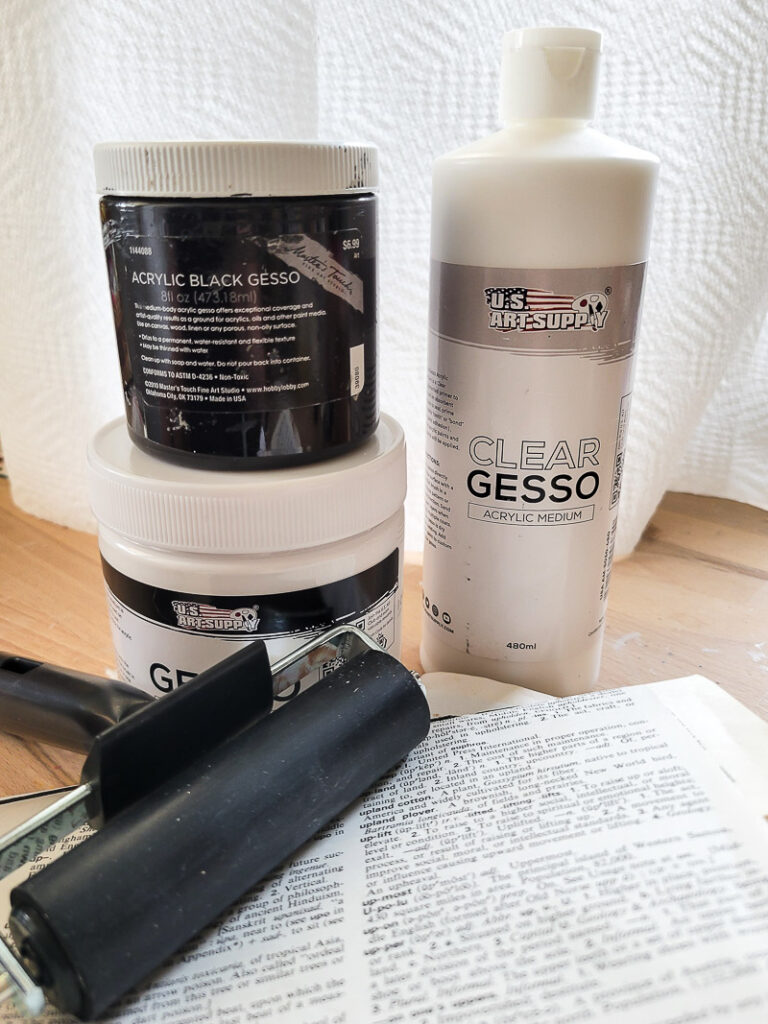
Materials & Mediums:
- Gesso – A white, black, or clear paint mixture used as a primer for surfaces like canvas or paper to prepare them for painting.
- Matte Medium – A gel medium that provides a smooth, non-reflective finish to surfaces.
- Gel Medium – A versatile acrylic medium that enhances texture and transparency, often used for glazing, transferring images, or creating texture.
- Modeling Paste – A thick paste used to add dimension to surfaces, creating texture or for molding purposes.
- Acrylic Paint – Water-based paint made with pigment suspended in an acrylic polymer emulsion; fast-drying and versatile.
- Watercolor – Transparent paint made with pigments suspended in water and often applied to paper.
- India Ink – A dark, pigmented ink often used for drawing or calligraphy.
- Pigment Powder – Fine powder made from concentrated pigments that can be mixed with mediums to create colors.
- Distress Ink – A type of ink created to achieve a vintage or weathered look on paper.
- Alcohol Ink – A fast-drying, translucent ink made with alcohol; used for vibrant, colorful art.
- Encaustic Wax – A technique that uses heated beeswax mixed with pigment to create textured, layered artwork.
- Oil Pastel – A pigment-based art material with an oil binder, offering a smooth, blendable texture.
- Chalk Pastel – A soft, powdery medium made from pigments and a binder, offering rich, blendable colors.
- Acrylic Ink – Highly pigmented, liquid acrylic paint that is vibrant and fast-drying.
- Gouache – Opaque watercolor paint that provides a solid, matte finish.
- Pan Pastels – Soft, highly-pigmented pastel color in a pan form, used for smooth blending.
- Fabric Paint – Acrylic-based paint designed for use on fabric, often used for crafting or clothing designs.
- Inktense – Ink-based, vibrant, and permanent color medium in a watercolor pencil form.
- Glaze – A thin, transparent layer of paint or medium applied over dry layers to alter its appearance.
- Stain – A coloring agent or medium used to soak into a surface, often used on wood or paper to enhance texture.
- Mica Powder – Fine, reflective powder used to create shimmer or highlights in art projects.
- Resin – A liquid that hardens into a clear, glossy finish, often used for jewelry, casting, or as a protective coating.
- Texture Paste – A thick paste used to create raised textures on surfaces, often mixed with pigments.
- Collage Medium – A gel medium used to adhere paper or other materials to surfaces in collage art.
- Gloss Varnish – A clear coating applied to artworks or surfaces to provide a shiny, protective finish.
- Spray Ink – Ink in a spray form used to create sprays or mist effects in art.
- Water-Soluble Crayon – Crayons that can be activated with water to create watercolor-like effects.
- Image Transfer Gel – A medium that allows you to transfer images from one surface to another.
- Embossing Powder – Powder that is used in heat embossing to create raised, textured designs on paper.
- Pigment Pen – Pens filled with colored pigment ink, often used for detailed drawing or outlining.
- Metallic Acrylic – Acrylic paint with metallic pigment to give a shiny, reflective finish.
- Dye Ink – Ink that is made from dye and offers a bright, transparent color, typically used in stamping.
- Iridescent Medium – A medium that adds a shimmering, pearlescent effect to artwork.
- Cold Wax – A medium used to add texture and a matte finish to oil paintings, can be mixed with paint.
- Crackle Paste – Paste that creates a crackled effect when it dries.
- Binder Medium – A medium that holds pigment together in paints, pastels, or other materials.
- Pastel Ground – A textured surface applied to paper to help hold pastel pigments in place.
- Watercolor Ground – A surface preparation used to make non-watercolor paper suitable for watercolor paint.
- Oxide Ink – Ink that produces an oxidized or rusty effect, often used in vintage art techniques.
- Pearl Ex – Powdered pigments that offer a metallic or pearlescent finish when applied to artwork.
- Heavy Body Acrylic – Acrylic paint with a thick consistency, ideal for impasto or textured techniques.
- Fluid Acrylic – A thinner acrylic paint used for glazing, washes, or fluid pouring techniques.
- Acrylic Gouache – A matte, opaque medium that combines the properties of gouache with acrylic’s versatility.
- Liquid Watercolor – Water-based, vibrant pigment in liquid form used for watercolor painting.
- Chalk Paint – A type of paint that provides a matte finish, typically used for furniture and home décor projects.
- Linseed Oil – An oil used as a medium or binder in oil painting, known for its slow drying time.
- Fixative Spray – A spray that protects drawings or pastel work by preventing smudging or fading.
- Blending Medium – A medium used to facilitate smooth transitions between colors when painting.
- Decoupage Glue – A glue used for adhering paper or fabric to a surface in a layered, decorative style.
- Acrylic Retarder – A medium that slows the drying time of acrylic paint, allowing for more blending time.

Techniques & Tools:
- Stenciling – A technique where a template is used to apply paint or ink to create a design.
- Layering – The process of adding multiple layers of materials or mediums to create depth or texture.
- Mark Making – The creation of marks or patterns on a surface as a way of expressing ideas or emotions.
- Dry Brushing – A technique where paint is applied with a dry brush, often used to create texture or highlights.
- Collaging – The art of assembling different materials, such as paper or fabric, to create a composition.
- Image Transfer – The process of transferring an image from one surface to another using various mediums.
- Resist Technique – A technique where a material resists or repels paint or ink to create patterns or effects.
- Splattering – A technique where paint or ink is flicked or splattered onto a surface for a random or textured effect.
- Blending – The process of smoothly transitioning between two or more colors or mediums.
- Embossing – The process of creating raised patterns on paper or other materials using heat and embossing powder.
- Smudging – The technique of blending or softening the edges of marks, typically with fingers or a blending tool.
- Brayering – Using a brayer (roller) to spread ink, paint, or other mediums on a surface.
- Ink Smooshing – A technique where ink or paint is spread or pressed to create a textured, smeared effect.
- Fussy Cutting – The process of cutting around intricate shapes or details in paper or other materials.
- Paper Tearing – Tearing paper rather than cutting to create a rough, organic edge in art.
- Masking – A technique that involves blocking out areas to prevent paint from covering them.
- Sgraffito – A technique where a top layer of paint is scratched or scraped to reveal the layer beneath.
- Stamping – The process of applying ink or paint to a stamp and pressing it onto a surface to create an impression.
- Heat Setting – Using heat, such as a heat gun or iron, to set or dry certain materials, often in fabric art or embossing.
- Glazing – A technique where thin layers of transparent paint or medium are applied over dry layers to alter color or texture.
- Burnishing – The process of rubbing a surface to smooth it or create a shiny finish.
- Frottage – A technique where textures are transferred from an object onto paper by rubbing.
- Monoprinting – A printmaking process that allows for the creation of a single, unique print from a painted surface.
- Gel Printing – A form of monoprinting using a gel plate to create prints with various textures and layers.
- Watercolor Bloom – A watercolor effect where water and pigment react to create a blossoming or spreading appearance.
- Scripting – The art of writing in a decorative, expressive style, often seen in calligraphy.
- Doodling – The act of drawing simple or spontaneous designs, often while distracted or in a free-flowing style.
- Collagraphy – A printmaking technique where materials are glued to a surface to create texture before printing.
- Etching – A printmaking process where a design is carved or etched into a surface and then inked to create prints.
- Lifting (Paint) – The process of removing or lifting paint from a surface to create lighter areas or highlights.
- Washes – Thin layers of paint or ink, often diluted with water, to create a translucent effect.
- Shading – The technique of adding darker tones to areas of an artwork to create depth or dimension.
- Highlighting – The technique of adding lighter areas to an artwork to emphasize certain features or create contrast.
- Misting – Spraying a fine mist of water or ink onto a surface to create an effect or wetting the surface before applying paint.
- Binding Edges – The process of securing the edges of a book or journal, often with stitching or gluing.
- Underpainting – The first layer of paint applied to a surface, often used to establish values or tones.
- Toning – Adding a wash or glaze of color over an artwork to adjust its overall tone or mood.
- Dry Embossing – The process of creating raised patterns on paper using pressure without ink or paint.
- Wet-on-Wet – A painting technique where wet paint is applied onto a wet surface, allowing for blending or diffusion.
- Wet-on-Dry – A technique where wet paint is applied to a dry surface, allowing for sharp lines and clear details.
- Tinting – The process of adding white to a color to lighten it.
- Negative Space – The empty space around and between objects in an artwork, often used to create a sense of balance.
- Texture Rubbing – A technique where a textured object is rubbed against paper to transfer its pattern or texture.
- Color Blocking – The use of contrasting blocks of color in a composition to create a bold, modern look.
- Ghosting – A faint impression left by a stamp or stencil, typically created by not applying enough ink or paint.
- Reverse Stamping – A technique where a stamp is used to create an impression on a surface and the negative space is used as the artwork.
- Paint Pouring – A fluid painting technique where paint is poured onto a surface and manipulated to create marbled effects.
- Color Mixing – The process of combining different colors to create new hues, shades, or tones.
- Masking Fluid – A liquid applied to areas of paper to mask off regions from paint or ink.
- Transfer Foiling – A technique where adhesive is applied to an artwork and foil is transferred onto it for a shiny, metallic effect.

Bookbinding & Journal Structure:
- Signature – A group of pages that are folded together to form a section of a book, which is then sewn or bound into the book.
- Coptic Stitch – A type of bookbinding stitch where signatures are sewn together with exposed stitches along the spine.
- Saddle Stitch – A simple bookbinding method where signatures are sewn together along the spine using a single thread.
- Long Stitch – A bookbinding technique where signatures are sewn through the spine and across the length of the book, leaving visible stitches.
- Pamphlet Stitch – A basic stitch used for binding a small booklet with a single signature, typically involving two or three holes.
- Perfect Binding – A method where the book’s pages are glued together along the spine, commonly used in paperback books.
- Concertina Fold – A type of fold in which paper is folded back and forth, like an accordion, creating a continuous page.
- Accordion Book – A book structure created using concertina folds, where the pages fold out like an accordion.
- Codex – An ancient book format where individual pages are sewn or bound together to form a spine, the predecessor of modern books.
- Book Block – The collection of pages that make up the core of a book before they are bound into a cover.
- Deckle Edge – A rough, irregular edge on paper, often left after the paper is torn from a mold during its creation.
- Headband – A decorative or structural band sewn along the top of a book’s spine, often for both aesthetic and reinforcement purposes.
- Tailband – Similar to the headband, this decorative band is sewn along the bottom of the spine.
- Endpapers – The sheets of paper glued to the inside covers of a book, often used for reinforcing the structure.
- Fore Edge – The edge of the book opposite the spine, often trimmed for neatness or decorated.
- Book Cloth – A fabric material used to cover the book’s boards, typically providing durability and aesthetic appeal.
- Bookboard – A thick, rigid material used for the covers of books, often made from cardboard or chipboard.
- Text Block – The main body of pages in a book, including the printed material, bound together.
- Spine Reinforcement – Additional material or techniques used to strengthen the spine of a book, ensuring durability.
- Grain Direction – The direction in which the fibers of the paper are aligned; important in bookbinding for ensuring the paper folds and opens correctly.
- Bone Folder – A tool used to fold and crease paper or fabric without damaging it, often used in bookbinding and paper crafting.
- Scoring – A process of making light indentations in paper to help fold it neatly and precisely.
- Japanese Binding – A traditional bookbinding technique involving decorative stitching that exposes the spine in a series of intricate patterns.
- Exposed Spine – A binding technique where the stitching or structure of the spine is visible and part of the book’s design.
- Hinges – The flexible joints or folds in a book cover, allowing the cover to open and close.
- Hollow Back – A method used in binding where the spine of the book is hollow, allowing for flexibility and durability.
- Case Binding – A bookbinding method where the book block is sewn or glued into a pre-made cover, often using a hardcover.
- Cover Wrap – The fabric or material that wraps around the book cover, including the front, back, and spine.
- Text Weight Paper – Lightweight paper used for printing, writing, or in the body pages of a book.
- PVA Glue – A strong, archival-quality glue used in bookbinding for attaching pages or book blocks.
- Awl – A pointed tool used to make holes in paper or leather for stitching in bookbinding.
- Book Cradle – A tool or stand used to hold a book open or in position while being worked on, especially during binding.
- Book Press – A tool used to apply even pressure to books while they are being bound or glued, ensuring smooth, tight bindings.
- Mull (Super Cloth) – A strong, cloth-like material used to reinforce the spine of a book.
- Flyleaf – A blank page at the front of a book, sometimes used for decorative purposes.
- French Link Stitch – A type of binding stitch that links each signature to the next in a decorative and secure pattern.
- Buttonhole Binding – A binding technique where the pages are sewn using a buttonhole stitch for a secure, decorative finish.
- Drum Leaf Binding – A technique where pages are attached to the spine with one single sheet of paper glued between each signature.
- Weft (Paper/Fabric) – The horizontal threads in woven paper or fabric, running across the warp threads.
- Warp (Paper/Fabric) – The vertical threads in woven paper or fabric, providing the structure and strength.
- Chain Stitch – A type of stitch that creates a chain-like appearance, often used in bookbinding for decorative or structural purposes.
- Kettle Stitch – A binding stitch used to link the signatures together and secure the book block, often used in traditional handbinding.
- Board Shear – A tool used to cut bookboard to size in a clean and straight line.
- Sewing Frame – A tool that holds signatures in place while they are being sewn together during bookbinding.
- Punch Template – A template with pre-made holes used to guide stitching in bookbinding.
- Stitch Length – The measurement of the space between each stitch when sewing a book, affecting the appearance and strength of the binding.
- Gutter Margin – The inner margin of the pages, adjacent to the spine, allowing space for the binding without obscuring the text.
- Book Hinge Gap – The small gap in the hinge area of a book that allows the pages to open smoothly.
- Tacket Binding – A bookbinding technique where small stitches or tacks are used to hold together signatures.
- Hinge Score – A technique for scoring the area near the book’s hinge, allowing for a smooth opening and closing of the cover.
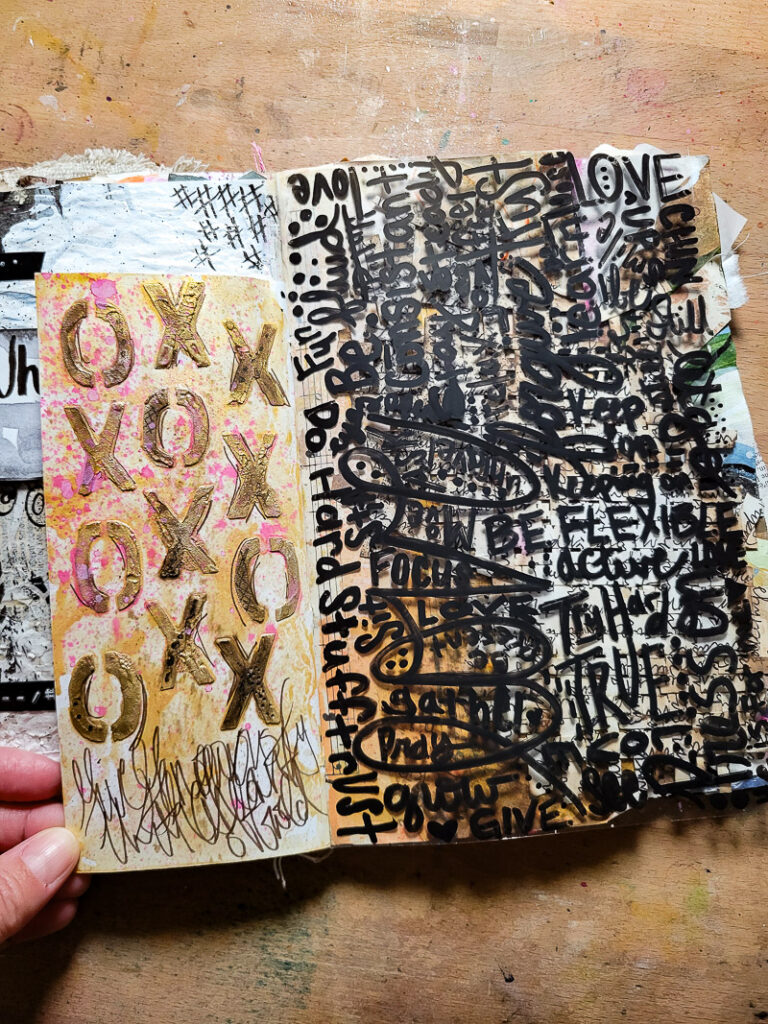
Textures, Surfaces & Effects:
- Crackle Finish – A textured effect where the surface of paint or medium develops fine cracks, often used for a vintage or aged look.
- Matte Finish – A non-glossy, flat finish on a surface, often used to reduce glare and create a subtle, understated appearance.
- Gloss Finish – A shiny, reflective surface finish, typically used to enhance colors and provide a smooth, high-gloss look.
- Satin Finish – A finish that sits between matte and gloss, offering a soft sheen without the shine of a gloss finish.
- Metallic Effect – A finish that imparts a metallic look to the surface, giving it the appearance of metal, often achieved with special paints or foils.
- Velvet Texture – A rich, soft texture, often created with velvety paper or fabric, adding a tactile, luxurious quality.
- Burlap Weave – A rough, woven texture often associated with burlap fabric, commonly used for rustic or country-themed projects.
- Paper Grain – The natural pattern of fibers in paper, which affects its texture and how it behaves when folded or printed on.
- Canvas Texture – A thick, textured surface resembling a canvas, often used for painting or other artistic media.
- Linen Finish – A smooth texture with a linen-like appearance, often used for elegant and formal papers.
- Embossed Texture – A raised design on paper or another surface, created by pressing or stamping the material.
- Debossed Texture – A recessed design on paper or another surface, created by pressing the material into a mold.
- Raised Relief – A surface effect where parts of a design are raised above the surrounding area, often used for decorative purposes.
- Handmade Paper – Paper made by hand, often featuring a rough texture and natural imperfections that give it a unique, organic quality.
- Mulberry Paper – A type of handmade paper made from the bark of the mulberry tree, often used in Asian paper crafts.
- Vellum – A smooth, translucent paper often used for formal invitations or fine art.
- Parchment – A type of paper that mimics the look and feel of animal skin, often used for formal documents or calligraphy.
- Kraft Paper – A strong, brown paper often used for packaging or rustic-themed crafting.
- Patterned Paper – Paper that features pre-printed designs, patterns, or textures for decorative purposes.
- Book Text Paper – High-quality, lightweight paper commonly used for printing books, often smooth and acid-free.
- Washi Tape – Decorative paper tape originating from Japan, often used for adding color, patterns, or texture to projects.
- Tissue Paper – A thin, delicate paper, often used for wrapping, layering, or decorative purposes.
- Acetate Sheet – A thin, clear plastic sheet commonly used for overlays, window inserts, or transparent elements in projects.
- Transparency Film – A clear film used for printing images that can be viewed from the front and used for overlays or projections.
- Glassine – A smooth, translucent paper often used for packaging, layering, or creating subtle textures in mixed media.
- Glossy Cardstock – A type of heavy paper with a smooth, shiny finish, often used for printing high-quality images or designs.
- Textured Cardstock – Paper with a raised or textured surface, adding depth and tactile quality to crafting projects.
- Chipboard – A thick, sturdy paperboard material often used for book covers, album pages, or other structural elements.
- Corrugated Paper – Paper with a ridged texture, often used for creating durable structures or for adding a unique texture.
- Ephemera – Paper items or artifacts, such as tickets, postcards, or labels, often used in scrapbooking or collaging.
- Ledger Paper – Paper with printed lines, typically used for accounting or journaling, often with a vintage look.
- Music Sheet – Paper printed with musical notation, used for creating music-related projects or decorations.
- Dictionary Page – A page from a dictionary, often used in collages or mixed media art for its text and vintage appeal.
- Transfer Paper – Paper used to transfer images or designs onto another surface, commonly used for tracing or heat transfer.
- Faux Leather – Synthetic material made to mimic the appearance and texture of leather, often used for book covers or crafting projects.
- Faux Finish – A paint or surface treatment technique that mimics the appearance of another material, such as wood, stone, or metal.
- Painted Paper – Paper that has been painted with a design or color, often used as a base or texture in mixed media artwork.
- Inked Edge – The technique of adding color or ink along the edges of paper or cardstock to create a distressed or defined look.
- Tea Staining – A technique where paper or fabric is soaked in tea to give it an aged, vintage look.
- Coffee Dyeing – Similar to tea staining, this technique uses coffee to stain paper or fabric, creating a rich, brown hue.
- Paper Distressing – A technique of aging or weathering paper by tearing, crumpling, or inking edges, creating a worn, vintage effect.
- Embellished Edge – A decorative edge treatment applied to paper, such as stitching, inking, or gluing for added visual interest.
- Grunge Texture – A rough, distressed texture often used to create a worn or gritty appearance in art or design.
- Speckled Effect – A pattern of small, scattered dots or specks, often achieved by splattering paint or ink.
- Wax Resist – A technique in which wax is applied to a surface to resist paint or ink, creating areas that remain uncolored.
- Texture Mapping – A technique used in digital or mixed media art to apply textures to a surface or design.
- Spray Adhesive – A type of glue that comes in an aerosol spray, used to adhere paper, fabric, or other materials quickly and evenly.
- Gold Leafing – The application of thin gold sheets to a surface to create a luxurious, metallic effect.
- Foil Transfer – A technique in which heat or adhesive is used to apply metallic foil to a surface, creating a shiny, reflective design.
- Heat Embossed Finish – A technique where embossing powder is melted onto a surface with heat, creating a raised, shiny effect.
Was this list helpful to you? Let me know in the comments! Also, make sure you save it for later in case you need a quick review or have a question!


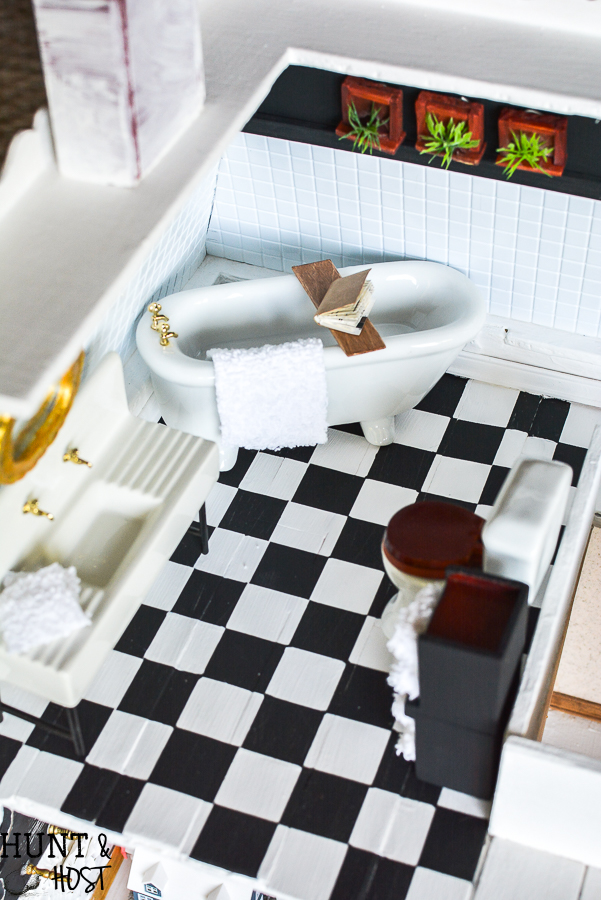
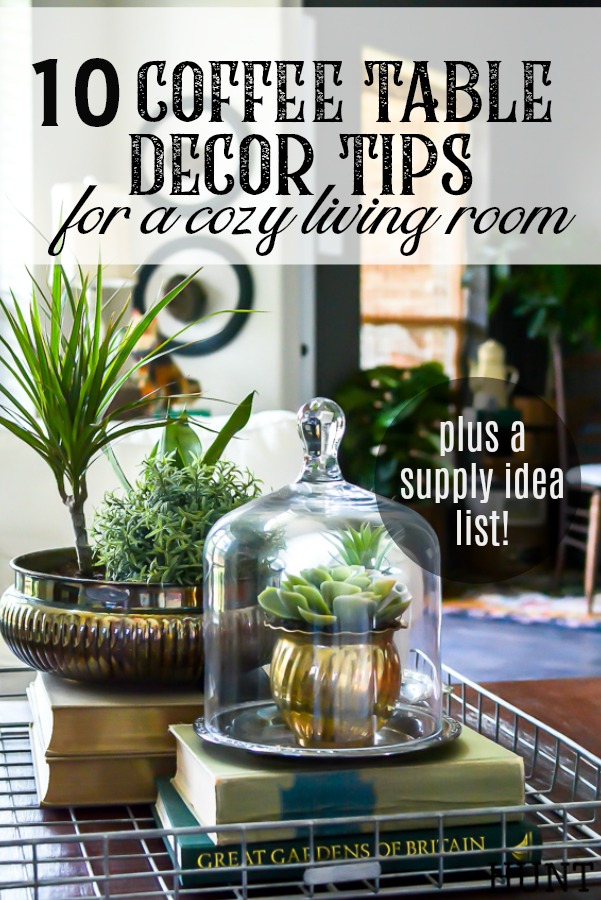
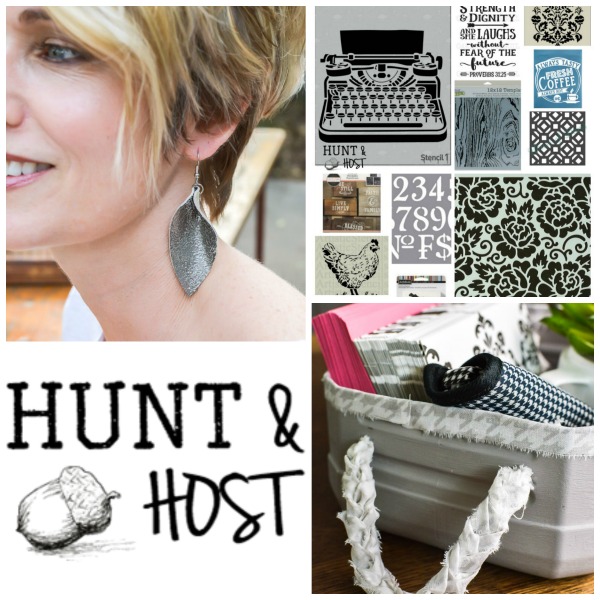


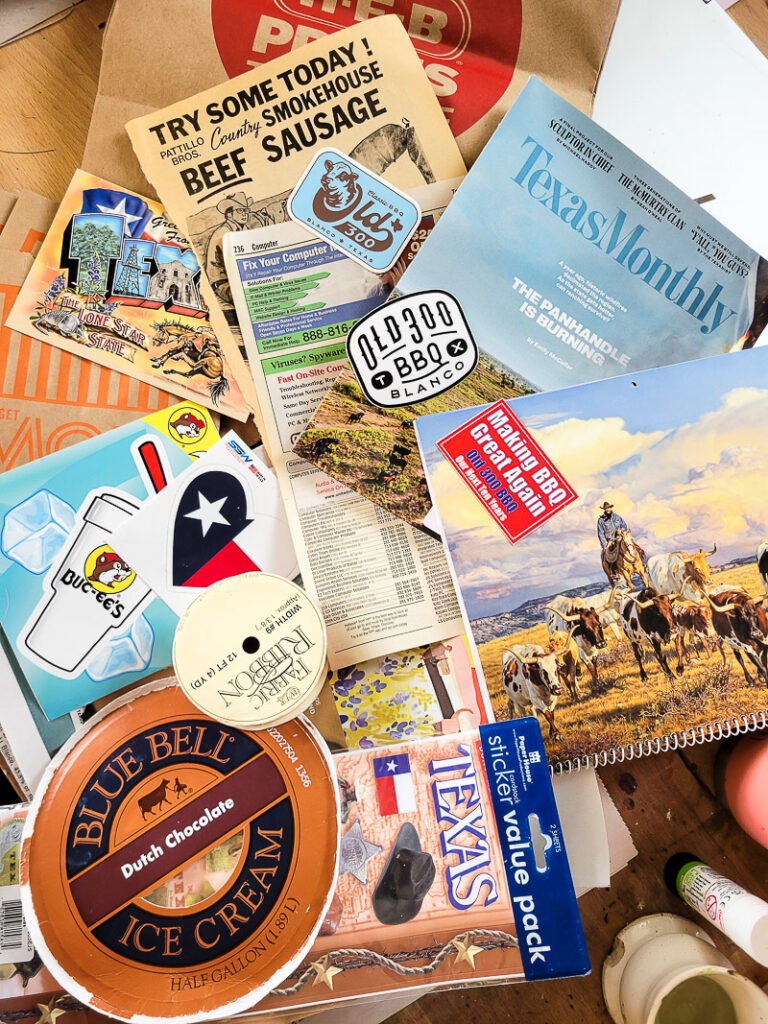
This is just a fantastic list!!
yayyyy thanks Holly, glad you like it!
This is incredibly helpful! Thank you for such a complete list.
you are so welcome! I hope it is handy for you!
This is amazing! I am going to print and laminate this for my supply table. When you haven’t used something in a while, it is sometimes hard to remember what it is for. This also helps in considering appropriate substitutions. THANK YOU for this fantastic resource. 🙂
Thanks Lori – great idea, you can definitely use it a ton of ways!
Love this list! Thanks so much for putting it all together. I see so many techniques & tools that I haven’t tried or used.
yayyy – so happy it was helpful!